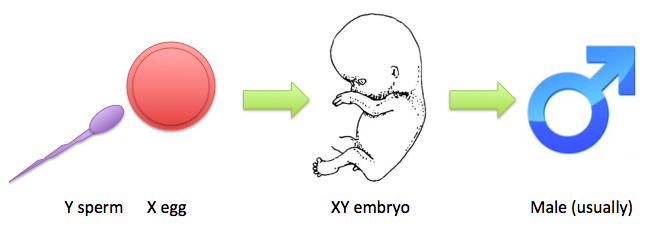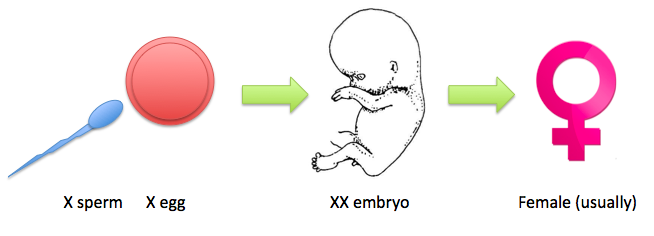Sex chromosomes
Most human embryos have 46 chromosomes in every cell. There is a pair of each chromosome numbered 1 to 22, and other chromosomes ("sex chromosomes") labelled X and Y. Male embryos usually have an X and a Y chromosome in every cell, whereas females have two Xs. Although most people have either an X and a Y (those people are designated 'XY'), or two Xs ('XX'), other chromosome combinations are possible, such as XXY or just X (designated 'X0').
A person’s sex is usually a question of whether the Y chromosome is present or not (XY -> male, XX -> female), but that is not always the case. For example, in some people, not every cell in the body has the same set of chromosomes; or, in some people, a Y chromosome may be present but not fully functional. In other words, there are many situations involving non-typical numbers, structures or functions of sex chromosomes that can cause embryo development to vary from that of a typical male or typical female.
When a human egg (from the mother) is fertilised by a sperm (from the father), together they form an embryo. The egg and sperm cells each contain a set of chromosomes - so the embryo comes to inherit essentially a duplicate set of chromosomes containing all the genetic instructions required for life, one set from the mother, one from the father. A person’s chromosomal profile is called their karyotype.
One particularly important pair of chromosomes is the sex chromosomes which, as the name implies, determine the sex of the embryo. The sex chromosomes are the X chromosome and the Y chromosome. An oocyte (egg cell) from the mother almost always carries a single X chromosome, while a sperm cell from the father typically carries either an X or a Y chromosome (but not both). Depending on which type of sperm cell (X- or Y-bearing) fertilises the egg, an embryo with either two X chromosomes (that is, a sex chromosome karyotype of XX) or one X and one Y (XY) normally results. XX embryos usually develop as female, and XY embryos usually develop as males.


Occasionally, due to errors in the mechanisms involved in counting and distributing chromosomes when cells divide, embryos may end up with other combinations of sex chromosomes. Embryos that have one, three or four X chromosomes (X0, XXX or XXXX) instead of the regular two are usually born female, while embryos that have two X chromosomes plus one Y chromosome (XXY) are usually born male. This information tells us that whether a child develops as male or female most often depends on whether they have a Y chromosome, rather than being a question of the number of X chromosomes present.
One exception occurs when the Y chromosome is present, but is missing a part that required to promote male development. Chromosomes sometimes break, such that a fragment can be lost from the end, sometimes two breaks can occur, and during repair the two outside pieces can re-join and exclude the middle fragment. Alternatively, all the necessary genes might be present, but some of them may have small variations in the genetic code that alter or abolish gene function.
Another exception that sometimes occurs is the formation of an embryo whose cells don’t all have the same sex chromosome content. Some cells of the early embryo may lose one or more sex chromosomes, causing a condition called mosaicism. In this case, the sex of the embryo is governed by which population of cells goes on to form the gonads during fetal life (see Sex determination).
What this tells us is that a person's genetic sex (the particular combination of sex chromosomes a person has) is not always the same as the person’s biological sex — male, female or other (see also Sex, gender and sexual orientation). For example, an XY embryo may not develop as a male if the Y chromosome does not function correctly. Such an embryo may become an XY female, or an XY person of indeterminate or intermediate sex.
------------------------------------
Last updated: 3 August 2012 PK
Edit history: Author P. Koopman 9/2009; revised PK 5/2011, 9/2012, 5/2013, 9/2013, 7/2015